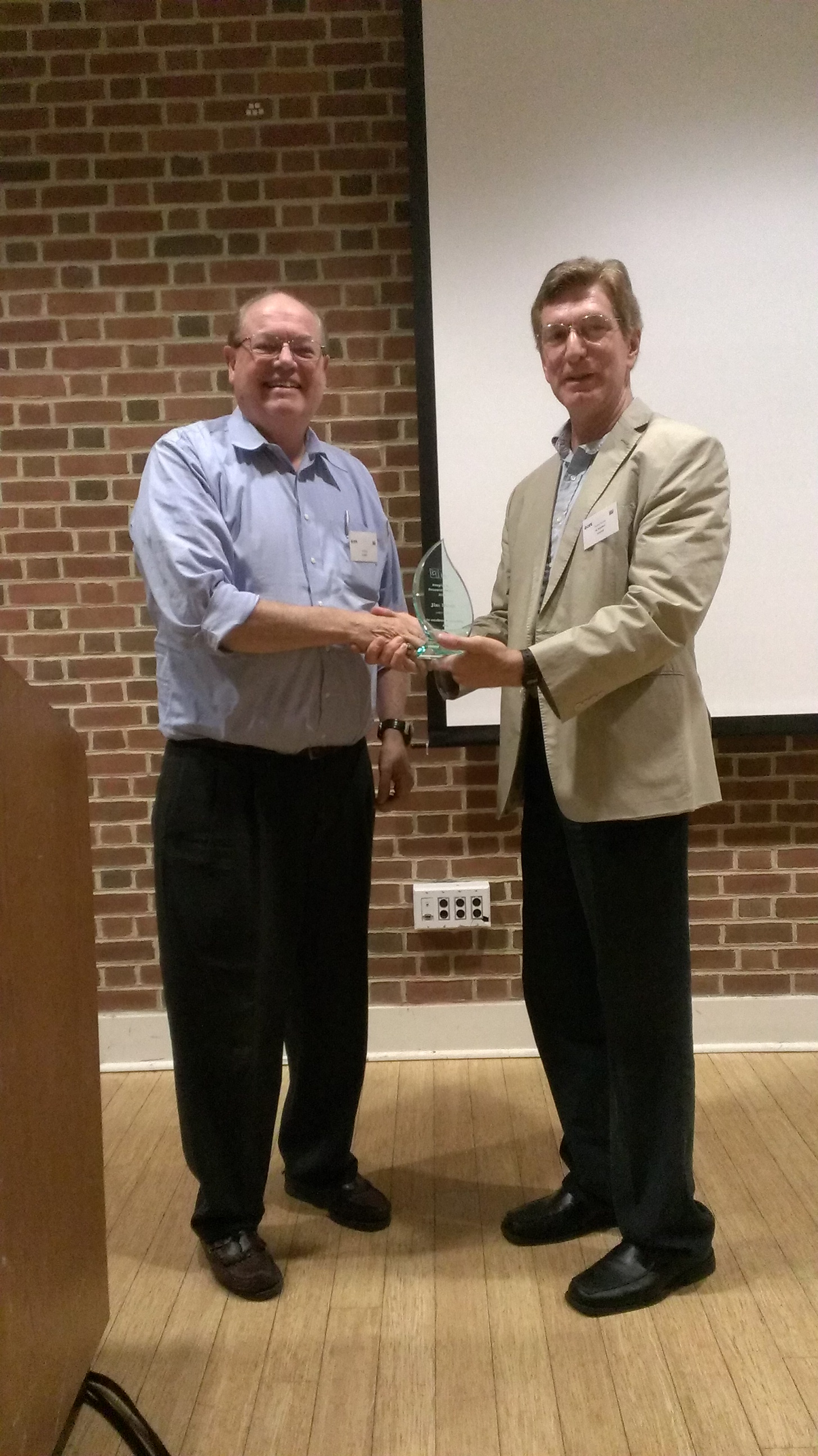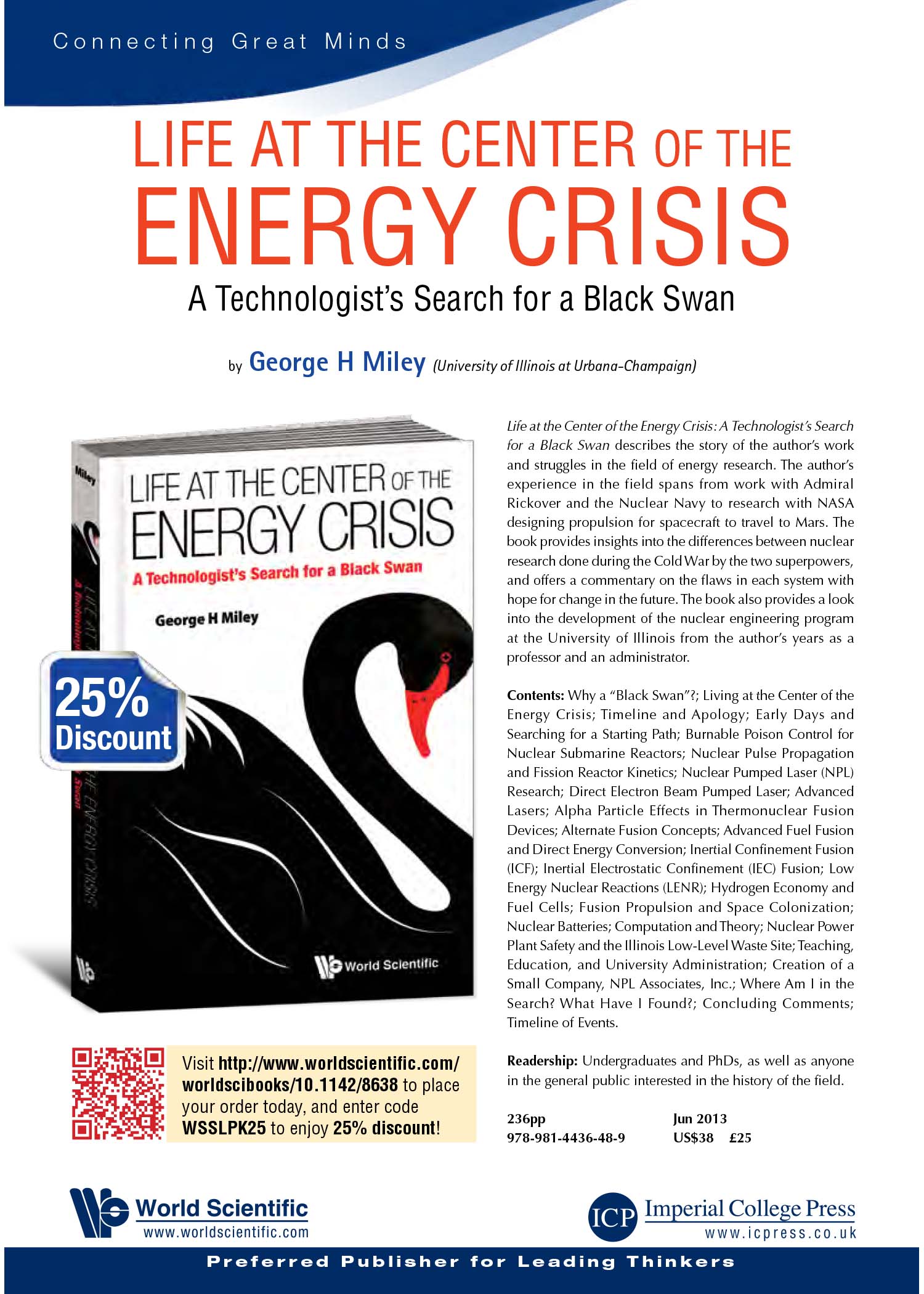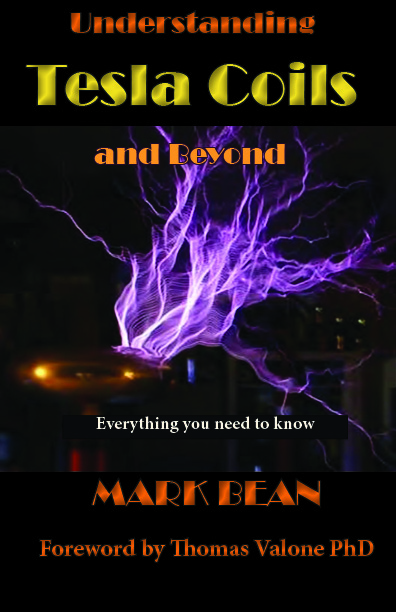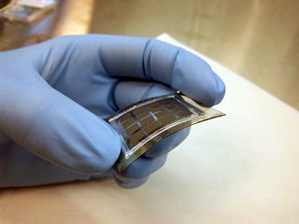|
|
|
Greetings!
This week marks the release of the Vol. 1, No. 1, July
10th 2013 issue of "Tesla Magazine" with an
article of mine on "Tesla's Wireless Energy Explained". The
magazine is financed by the Tesla Science
Foundation and published in Toronto, Canada. The
website apparently is still under construction at www.teslainfo.org but
the Foundation website is a great resourcehttp://teslasciencefoundation.org/index.php/en/ .
I'm also off this week to the Nexus Youth
Summit at the UN to participate in a panel on
"The Future of Energy," which may help to spread the word
about our institute's trailblazing work in that area.
Our first article is a summary of our latest Conference
on Future Energy (COFE6) with everything from solar to
cavitation fusion, which was held at the U of Maryland for two days.
All of the COFE6 presenter's Flash videos are now
online atwww.futurenergy.org for
anyone to review for free. We plan to publish the Proceedings
of COFE6 sometime later in the summer to accommodate a
few speakers with late submissions.
Can't say enough good things about Story #2 and our
latest publication, Understanding
Tesla Coils and Beyond by my good friend and
colleague, Mark Bean. The wonder of it all is the command of the
science that is immediately apparent upon reading it. Mark knows not
only Spark Gap Coil designs of Tesla coils but also the newest craze,
Solid State Coils as well. The solid state version lets practitioners
couple music into the Tesla coil discharge, instead of using
speakers, for an eerie metallic-electric sound that is very unusual.
Lastly, Mark also covers the Vacuum Tube coil designs and Advanced
Topics which makes for a really complete TC design book. And with Tesla's
wireless electricity coming soon, every engineer will want to know
more about the ways to create the generators and receivers.
As 3D printing is now being used for more unusual
creations, how about the world's first printed battery? Yes, Harvard
University and the University of Illinois are credited for this
breakthrough in manufacturing microbatteries. An online video is also
included in our Story #3.
Will we see more solar powered aircraft soon? Our
Story #4 is also a first since the Solar Impulse has flown across the
country and also in Europe. We also know that the military has been
interested in such a plane for years. Next year the company hopes to
do a round the world trip as well.
Willow glass is the secret also used on iPhones for
flexibility and resistance to breakage in our Story #5. Now what if
that glass was used in solar panels or even solar shingles that can
be nailed to the roof? Corning Glass believes that this will produce
a low cost alternative to most solar panel home installations.
Sincerely,
Thomas
Valone, PhD, PE.
Editor
|
|
|
QUICK LINKS
|
|

LIKE US ON FACEBOOK AND GET
10% OFF ANY ITEM IN OUR CATALOG!
 
|
|
|
1) Renewable and
Non-Conventional Energy Technology at COFE6 a Great Success
|

Sixth International Conference on Future Energy
July 14, 2013 - Washington DC. The Sixth
Conference on Future Energy
(COFE6) www.futurenergy.org was a great
success at the University of Maryland with a list of cutting
edge energy developments that are unique to the IRI approach to
public education.
Our
plenary speaker, Dr. Max Fomitchev-Zamilov from Penn
State University presented a talk on
and demonstration of experimental cavitation fusion that
can power the future with his cavitation reactor.
|

|
|
Jim
Dunn receiving the "Integrity in Research Award" from
President T Valone.
|
John Finnerty from Standard Solar spoke about the first Maryland Solar grid
technology.
Jim Dunn
who is a former CEO of NASA's Center for Technology Commercialization
presented his latest assessment of energy developments. Jim was
also this year's recipient of the "Integrity in
Research Award" for his tireless efforts in
researching and promoting new energy sources all over the US and the
world.
Francis
McCabe summarized his research into Gyro and Inertial
Propulsion, which caused a shudder last year when an engineer from Boeing announced at COFE5 that
many aerospace industries are using gyroscopic inertial propulsion on
satellites.
Dr. Thorsten Ludwig
from Germany gave two excellent presentations: His findings on the
Coler magnetic current apparatus and the second regarding an
experiment to measure subtle influences on a single electron
spin. James Putnam presented on the Empirical Origins for Force
and Acceleration.
Dr. George Miley presenteed his life story of the fusion research
he performed everywhere in the world, which is also the subject of
his autobiography just published by World Scientific Imperial Press
College and available through Amazon. The
book's title is

"Life
at the Center of the Energy Crisis, A technologist search for a black
swan" We highly recommend it , especially to
students.
.Matt Emery, who is an expert from www.Leedskalnin.com(Coral Castle),
gave an excellent summary of Leedskalnin's work.
We
also heard from Sterling Allan, Founder and CEO of
Pure Energy Systems, via remote from Brazil, present his
summary of five top emerging
energy technologies nearing the market.
We
were extremely pleased to have Nick Simos from
Brookhaven National Labs present his amazing classical physics
analysis of Nikola Tesla's wireless transmission of electrical power
which gives it a high feasibility rating. His slide show is
posted online
Also,
Dave Froning's prerecorded slide presentation on
electromagnetic confinement for nuclear fusion was
excellent.
The
Closing talk was presented by IRI's President, Tom Valone on Zero Point Energy
Harvesting as the most promising energy source for the new
millennium.
We
are happy to let you know that all the slide show presentations have
been recorded and are available FOR FREE online
at www.futurenergy.org .
Just click on each speaker's link and follow the instructions.
As we continue to strive to educate the public on all emerging energy
technologies, we look forward to your continued support through your donations to our
Non-Profit Institute and thank you for the generosity shown
throughout the years.
All
of us at IRI want to thank the attendees for supporting our
conference and all the volunteers who made it possible!
These conferences would not be possible WITHOUT YOUR
SUPPORT.
THANK
YOU!
|
2) New
Tesla Book: Understanding Tesla Coils and Beyond
|
Integrity
Research Institute Press Release July 22, 2013
An
amazing new book on Tesla Coils has just been released by our
Institute entitled: Understanding Tesla Coils and Beyond.
Everything you need to know.

Mark Bean
, the author of this extraordinary new book is a Tesla coil builder
and inventor who has wowed many Las Vegas stages with huge Tesla
Coils displays. He is one of the few living today that has the
knowledge and experience on building properly and safely these
fascinating devices. He also donated the publishing rights of
this book to our non-profit Institute.
Tesla
Coils create electrical magic, ordinary wall current is transformed
into spectacular displays of man-made lightning. Invented by Nikola
Tesla in the late 1800's, these fascinating devices have captivated
many. However much of the information about them has been lost to
time or neglect. This new profusely illustrated book
corrects this and more! It also provides a great balance between the
spark gap Tesla coil descriptions, vacuum tube
chapters and the solid state Tesla coil chapters, along with advanced
topics.
We
are sure that the hobbyist, technician, engineer and even the
professor will all learn something from the master builder Mark Bean
by reading Understanding Tesla Coils and Beyond. It
truly is "everything you need to know " about Tesla Coils .
Available on
our website and
on Amazon.com
back to table of contents
|
3)
First Ever 3D Printed Battery
|
Tech
Briefs, July 2013
A research team based at
Harvard University and the University of Illinois at Urbana-Champaign
has demonstrated, for the first time, the ability to 3D print a
battery. Their 3D-printed lithium-ion microbatteries are the size of
a grain of sand, and could supply electricity to miniaturized medical
implants, compact electronics, tiny robots, and more. To create the
microbattery, a custom-built 3D printer extrudes special inks through
a nozzle thinner than a human hair. Upon exiting the nozzle, the inks
immediately harden into layers as narrow as those produced by
thin-film manufacturing methods. Layer by layer, these inks create
the battery's anode and cathode.
The
inks contain nanoparticles of a lithium metal oxide compound, which
give the anode the proper electrical properties. A case then encloses
the electrodes and an electrolyte solution is added to create a
working microbattery. This tiny battery even has an electrochemical
performance comparable to commercial batteries in terms of charge and
discharge rate, cycle life, and energy densities.
|

|
|
Tiny 3D-Printed Battery
|
|
4)
Solar Powered Plane Completes Cross Country Flight
|
NEW
YORK - A solar-powered aircraft completed the final leg of a
history-making cross-country flight Saturday night, gliding to a
smooth stop at New York's John F. Kennedy International Airport.
The
Solar Impulse touched down at JFK at 11:09 p.m., completing the
final leg of the cross-continental journey that started in California
in early May. For Saturday's final leg, the aircraft left Dulles
International Airport a little before 5 a.m.

The
flight plan for the revolutionary plane, powered by some 11,000 solar
cells on its oversized wings, had called for it to pass the Statue of
Liberty before landing early Sunday at New York. But an unexpected
tear discovered on the left wing of the aircraft Saturday afternoon
forced officials to scuttle the fly-by and proceed directly to JFK
for a landing three hours earlier than scheduled.
Pilot
Andre Borschberg trumpeted the milestone of a plane capable of flying
during the day and night, powered by solar energy, crossing the U.S.
without the use of fuel.
"It
was a huge success for renewable energy," Borschberg said while
standing in front of Solar Impulse on the runway at JFK. "The
only thing that failed was a piece of fabric."
Bertrand
Piccard, the other pilot who took turns flying the Solar Impulse
across the United States, said the flight across the country tested
the entire project team.
"Flying
coast-to-coast has always been a mythical milestone full of
challenges for aviation pioneers," Piccard said. "During
this journey, we had to find solutions for a lot of unforeseen
situations, which obliged us to develop new skills and strategies. In
doing so, we also pushed the boundaries of clean technologies and
renewable energies to unprecedented levels."
Borschberg
noticed balance issues with the wing in the early afternoon Saturday
off the coast of Toms River, N.J., said Alenka Zibetto, a spokeswoman
for Solar Impulse.
Officials
said the pilot and aircraft didn't appear to be in danger. They said
the eight-foot tear on the lower left side of the wing wasn't
expected to worsen through the final portion of the trip.
"It
was supposed to be the shortest and easiest leg," Piccard said.
"It was the most difficult one."
Piccard
said in addition to the wing issue, another problem with the landing
was Borschberg's lack of air breaks to avoid making turbulence in the
wing with the tear.
Despite
the relatively short distance, Saturday's commuter-like hop was a
long flight that lasted 18 hours and 23 minutes. The slow-flying
aircraft was traveling between two of the world's busiest airports
and was required to take off very early in the morning and land very
late at night, when air traffic is at a minimum.
"This
is a leg where everybody is quite moved," Piccard said shortly
after the plane was in the air over Washington early Saturday.
The
aircraft soars to 30,000 feet while poking along at a top speed of 45
mph. Most of the 11,000 solar cells are on the super-long wings that
seem to stretch as far as a jumbo jet's. It weighs about the size of
a small car, and soars with what is essentially the power of a small
motorized scooter.
The
Solar Impulse left San Francisco in early May and has made stopovers
in Phoenix, Dallas-Fort Worth, St. Louis, Cincinnati and Dulles.
The
cross-country flight is a tuneup for a planned 2015 flight around the
globe with an up-graded version of the plane.
Solar
Impulse's creators view themselves as green pioneers - promoting
lighter materials, solar-powered batteries, and conservation as sexy
and adventurous. Theirs is the high-flying equivalent of the Tesla
electric sports car.
Europe
saw the solar plane first with a test flight from Switzerland and
Spain to Morocco last year.
Promoted
as solar-powered, what really pushes the envelope with this plane is
its miserly energy efficiency, Borschberg said before the flight.
back to table of contents
|
|
5)
Flexible Glass Cells could Make Tablets Lighter and Solar Power
Cheaper
|
MIT
Technology Review, July 2013
Researchers
at the U.S. government's National Renewable Energy Laboratory have
built flexible solar cells using a thin and pliable kind of glass fromCorning, the company that makes the
glass that covers iPhone screens. The new solar cells could make rooftop
solar power far cheaper.

Based
on tests by Corning, which makes a product called Gorilla glass for
iPhone screens and which announced the flexible material, called
Willow glass, last year, shingles made from such solar cells could
last for decades on a roof-even weathering hail greater than three
centimeters in diameter. Conventional solar panels are heavy, bulky,
and breakable, which makes them expensive to transport and install.
The
new solar shingles could be nailed to a roof in place of conventional
shingles. Rather than paying a roofer to put asphalt shingles on a
new home, and then paying solar installers to climb back up and mount
solar panels to the roof, the roofers could install solar shingles
instead of asphalt ones. The only added labor cost would be hiring an
electrician to plug the array of shingles into an inverter and
connect it to the grid. Thin, flexible solar shingles could also be
shipped more cheaply.
The
cost of installation is one of the largest parts of the overall cost
of solar power-its share has increased even as the cost of the cells
themselves has plummeted in recent years. Indeed, installation and
other auxiliary costs are now the biggest opportunity for reducing
the cost of solar power. An average rooftop solar system in
California costs $6.14 per watt, while solar panels themselves sell
for less than $1 a watt in many cases.
Solar
shingles are already available (see "Solar Shingles See the Light of Day"
and "Alta Devices Plans a Fast-Charging Solar
iPad Cover"). The chemical giant Dow makes them, for example. But
they are typically made of plastic. Glass-based shingles, as
counterintuitive as it sounds, could be more durable, says Dipak
Chowdhury, division vice president and Willow glass commercial
technology director at Corning. Glass is very good at sealing out the
elements, which can help solar cells last for decades. It's also
surprisingly strong, and, in its flexible form, resilient. "We
knew from our optical fiber work that glass is actually stronger than
steel when you try to pull it apart," he says. If Willow glass
shingles were hit by hail, they would flex rather than break. While
other solar shingles can also withstand hail, they may not be as good
at protecting solar cells from air and moisture, he says.
The
glass also makes it possible to use cadmium telluride as the solar
cell material. This is the only material that's been able to
successfully challenge conventional silicon solar cells at a large,
commercial scale (see "First Solar Shines as the Solar Industry
Falters"). Cadmium telluride solar cells need to be made on
a transparent material. Other flexible, transparent materials either
can't handle the high temperatures needed to make the solar cells, or
they block too much light, reducing efficiency.
Willow
glass could also be used for lighter, thinner gadgets, and even curved displays, perhaps even for a
rumored iWatch from Apple (see "Mobile Summit 2013: In Smart Watch
Category, Pebble Still Awaits the Big Competition"). For
both flexible displays and solar cells, glass needs to be not only flexible
but also very high quality, with a defect-free surface. Most glass is
formed by floating a layer of molten glass on top of a molten metal,
then gradually cooling it. The interaction with the metal can degrade
the surface. Willow glass forms in air-a sheet forms after molten
glass flows over the edges of a long trough. It is then spooled up
into large rolls with special equipment that keeps the surface
pristine. The defect-free surface is also key to making the glass
strong, since glass is only as strong as steel if its surface is free
of scratches and nicks. Once it's scratched, it requires much less
force to break. (Chowdhury says roofing tiles-as well as flexible
electronics-would have to be protected from scratches with a
coating of ethylene tetrafluoroethylene, or some other protective
polymer.)
Using
Corning's flexible glass in solar shingles will require careful
processing, much as is done now to create an iPhone display. An
iPhone actually contains several pieces of glass. The touch sensor, the
color filters that make up each pixel, and the millions of
transistors used to control them are all produced on top of separate
high-quality glass sheets. These are protected in an iPhone by
Gorilla glass, which is less susceptible to scratching, but isn't a
suitable surface for transistors or other electronics. Willow glass
could replace these interior sheets of glass. For rigid devices, the
main advantage of doing this would be to reduce weight and display
thickness-Willow glass is a third the thickness of the glass used
now.
The
cadmium telluride solar cells on Willow glass made at NREL were
small, proof-of-concept devices that aren't as efficient as the rigid
cells now on the markets, says Teresa Barnes, a scientist at NREL.
She says that in addition to improving efficiency, it will be
necessary to develop ways of handling larger flexible solar
cells-manufacturing equipment used now is optimized for handling flat
plates of glass.
Chowdhury
says another challenge will be persuading manufacturers and customers
that glass solar shingles can be durable: "Sometimes perception
wins over data."
back to table of contents
|
About Integrity Research Institute
Future Energy eNews is
provided as a public service from Integrity Research Institute,
a Non-Profit dedicated to educating the public on eco-friendly
emerging energy technologies.
FREE copy
of the 30 minute DVD "Progress in Future Energy" is
available by sending an email with
"Free DVD" in subject and mailing address in
body.
Your generous support is
welcome by making a tax deductible donation on
our secure website
|
|
|
|
- Scott Kelsey, Missouri State, explaining Rejuvamatrix, Pulsed EMF
therapy to increase the length of DNA telomeres, which directly
affect our lifespan.
- Max Formitchev-Zamilov, Penn State, discussing Cavitation Induced
Fusion, that will soon provide power generation and heat
production.
- Christopher Provaditis, from Greece, explaining Inertial
Propulsion and who teamed up recently with Boeing for their space
satellites.
- PJ Piper of QM Power, discussing the motor invented by
Charles Flynn, with a revolutionary parallel path that gives
double and triple efficiency.
- Dr Thorsten Ludwig from Germany (GASE) discussing
the mysterious Hans Coler motor that WWII British Intelligence
researched.
|
|
|
|
|
|
![]()




















